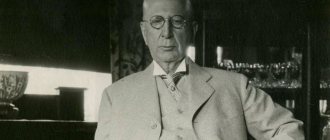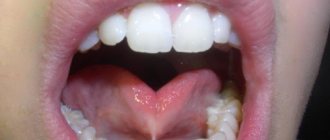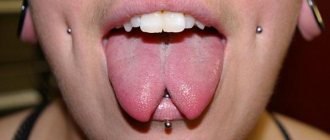The tongue is an organ of the oral cavity of humans and most vertebrates, which is directly involved in the process of chewing food, perceiving tastes, secreting saliva and producing articulate speech.
The length of the tongue is regulated by the frenulum, located in the lower part of this organ, attached to the bottom of the mouth. The average size of the hyoid ligament is about 3 cm. The presence of a shorter frenulum leads to a shortening of the length of the tongue, the development of abnormalities of the speech apparatus, and problems with eating.
To make your tongue longer, you need to regularly perform special exercises, massage the hyoid ligament, and pronounce tongue twisters.
When do adults and children need classes to lengthen their tongue?
Speech therapy exercises will help make the tongue longer, the use of which is an alternative to surgery.
Exercises to lengthen this part of the oral cavity are indicated in the following cases:
- an adult or child has limited mobility of the tongue, which affects the characteristics of speech reproduction;
- during a visual examination of the oral cavity, you can see that the sublingual ligament is too short, connected by a thin film filled with small veins of blood vessels;
- eating food takes too long, and in the process of chewing food a person gets very tired;
- performing basic actions of folding the tongue into a “tube” shape causes difficulties, and is also accompanied by a sound reminiscent of a click.
You can make your tongue longer with a set of developmental exercises. The decision to use this method of therapy must be made by a speech therapist. In this case, you should first consult a dentist.
If the doctor confirms that there is no need for surgical intervention, then you can begin working with a speech therapist.
What is the problem with the incorrect structure of the frenulum of the tongue?
In infants, an abnormal frenulum structure can cause difficulty sucking. In this case, the problem is solved in the maternity hospital by pruning. If the baby is still able to eat normally, doctors try to leave the situation alone, giving, as they say, time to grow. Indeed, in many cases, along with the growth of the jaw, the frenulum gradually stretches and takes on a normal shape.
In older children, a short hyoid frenulum creates some speech therapy difficulties:
How to make your tongue longer, the best ways
There are several basic non-surgical ways to lengthen the tongue. In this case, you can use speech therapy exercises, tongue twisters that develop the muscles of the tongue, as well as therapeutic massage.
Exercises
To stretch the hyoid ligament, articulation exercises are used, which gradually make the tongue longer. This type of therapeutic process is suitable for adults and children over 3 years of age.
Painter
The articulation exercise “Painter” is performed as follows:
- You need to smile and then open your mouth as wide as possible.
- After this, you should stroke the palate with the tip of your tongue, moving from the front teeth towards the throat. At this moment, the lower jaw should remain motionless.
- While performing these manipulations, you must pronounce the following words:
“It’s time for us to paint the house.
We called a painter.
We lower the jaw smoothly,
We help out the painter.”
This exercise is suitable for children of all age groups, as its implementation is not particularly difficult.
horse
The technique for performing the “Horse” exercise involves following the following algorithm of actions:
- You will need to open your mouth and make a wide smile.
- After this, you should click the tip of the surface of the tongue, imitating the sound of a horse’s hooves, saying the following words:
“Let's ride our horse.
Along the road smooth, smooth.
A neighbor invited us to stay.
Try the sweet cake.
We arrived at lunchtime.
But our neighbor is not there.”
The exercise for developing the length of the tongue “Horse” is performed with periodic pauses lasting 1-3 minutes, which provide an opportunity for the muscles under stress to recover.
Fungus
To master the “Mushroom” exercise, you must do the following:
- Open your mouth wide.
- Raise your tongue up, resting its tip against the mucous membrane of the palate.
- After this, you need to try to pronounce the following words:
“I stand on a thin leg.
I stand on a smooth leg.
I have a brown hat.
With my fluffy lining.”
The “Mushroom” exercise is considered quite complex, so it is best used to lengthen the tongue for older children and adults.
Harmonic
To perform the “Accordion” exercise, you will need to position your tongue exactly as during the “Mushroom” articulation exercise, but in this case you need to add a smile.
After this, you should smoothly open and close your mouth, and also try to pronounce the following words:
“We play the harmonica.
We open our mouths wider and wider.
I'll press my tongue to the sky.
I’ll lower my jaw.”
It is believed that during this exercise, not only the effect of articulatory stretching of the hyoid ligament is achieved, but also the facial muscles are significantly strengthened.
Drum
The drum is a simple exercise to increase the length of the tongue, the principle of which is as follows:
- You need to open your mouth wide.
- Place your tongue against the inside of the front teeth of the upper jaw.
- Then you should repeatedly and as clearly as possible pronounce the continuous sounds “D-D-D-D-D”.
How to make your tongue longer is one of the Drum exercises.
While performing this exercise, you must ensure that your mouth remains open at all times. Otherwise, it will not be possible to achieve a positive effect in lengthening the hyoid ligament.
Swing
To perform the “Swing” exercise, you must follow the following algorithm of actions:
- Open your mouth as wide as possible.
- Make a smile.
- Alternately move the tip of the tongue, touching the upper and lower teeth.
- Keep the lower jaw motionless.
- In the moment between moving the tongue, quickly pronounce the following words:
“I swing on a colored swing.
I go up and down.
I climb to great heights.
And then I go down again.”
From a technical point of view, performing this exercise is a rather complex process that will be difficult for children of the younger age group to master.
For adults, the “Swing” exercise is best suited.
Tongue stretching
Stretching the tongue is one of the simplest and most effective exercises, the implementation of which is as follows:
- It is necessary to stick your tongue out of the mouth.
- Pull the tip of the tongue in the direction of the nose, using only muscle strength.
- After feeling tired, lower your tongue closer to the beginning of your upper lip.
While performing this exercise, you must ensure that the lower jaw remains motionless at all times.
Extending the tongue towards the surface of the tip of the nose should be carried out to the limit of physical capabilities. Only with the use of this approach will it be possible to achieve a positive result.
Tongue Twisters
Using the method of pronouncing tongue twisters makes it possible to develop the muscles of the tongue and thereby increase its length.
It is worth noting that the positive effect of using this method is less pronounced than that of articulation exercises or speech therapy massage.
Despite this, in combination with other techniques, you can recite the following tongue twisters every day:
- Prokhor and his friend Pakhom rode together on horseback.
- The white bull's upper lip was blunt.
- Thick dust flies from the clatter of horse hooves across the black field.
- The jackdaw sat on top of the stick, the stick hit the jackdaw.
- Fenya has a signature sweatshirt, and Aunt Faya lives on Fontanka.
- Chicken "Chick" tenaciously clings to a solid chain.
- A water carrier brought water taken from the water supply.
- Mother gave her daughter Sasha whey from sour milk.
- The scales of a pike fish, the stubble of a Chukchi man.
- The striped bee buzzed and buzzed before the bloodthirsty spider.
Tongue twisters should be pronounced in one breath, trying to demonstrate maximum speed in reproducing sounds. All words must be consistent, but at the same time legible to the ear.
Speech therapy massage
Speech therapy massage is an effective method of lengthening the hypoglossal ligament. This method of therapy is carried out with the direct participation of a speech therapist or dentist.
The technique for performing speech therapy massage is as follows:
- The person sits down on a chair or dental chair, opens his mouth and sticks his tongue out.
- The specialist performing the massage uses a cut of a sterile bandage to pinch the tongue with his fingers, lifting it slightly upward to free access to the sublingual ligament.
- Then, with the thumb, index and middle fingers of the free hand, the speech therapist massages the frenulum, which limits the mobility of the tongue.
The average duration of a speech therapy massage is 10-15 minutes. depending on the well-being of the child or adult who needs tongue lengthening. In this case, a gag reflex may occur and the effect of excessive salivation may occur.
How to stretch the frenulum for children at home?
Stretching the frenulum at home should include regular articulation exercises, speaking tongue twisters that develop the muscles of the tongue, as well as the use of speech therapy massage.
Only an integrated approach using the above methods will allow you to achieve a positive result at home.
Tips and tricks
In the process of lengthening the tongue at home, it is recommended to follow the following rules:
- All movements of speech therapy exercises should be performed as slowly, smoothly and without sudden movements as possible.
- Children who study with a speech therapist should not perform exercises to the limits of their capabilities. A tongue limited by a too short hyoid ligament gets tired very quickly and requires a long rest.
- Performing exercises requires opening the mouth as wide as possible.
- Before starting tongue lengthening classes, it is necessary to thoroughly warm up and warm up the facial muscles by massaging them with your fingers.
- Speech therapy massage of the tissues of the hypoglossal ligament should be performed only by a qualified specialist with extensive practical experience.
Before deciding to use a new type of exercise or technique for lengthening the tongue, it is recommended to consult a speech therapist and dentist.
Massage
You can do a simple massage to lengthen the tongue: grab the frenulum at the very bottom under the tongue with two fingers (index and thumb) and pull your fingers along it to the tip of the tongue. You must try to pull it, but you cannot use much force so as not to damage the thin fabric. In each session you need to do several of these techniques. Your fingers will quickly begin to feel the frenulum, and this action will not cause discomfort. By doing a massage 4-6 times a week, a person will be convinced that the frenulum has changed in length.
If the frenulum is less than 8 mm, then it is better to stretch it rather than operate. After surgery, a scar remains on the frenulum, which will reduce its mobility. In addition, a child who has undergone surgery will be afraid to do exercises so as not to experience the pain that he experienced during the operation.
Therefore, the best way to lengthen the tongue is to lengthen it with special exercises.
For what indications is surgery performed?
You can make your tongue longer through surgery, but only if there are direct medical indications.
This treatment method is advisable to use in the following cases:
- it is impossible to install removable dentures in patients of the adult age group who have had most of their teeth removed;
- there are signs of a distorted smile;
- the anatomical proportions of the facial disc are disrupted;
- a small child does not gain weight and begins to lag behind in physical development due to a too short hyoid ligament, which interferes with the full implementation of the sucking reflex;
- there was a displacement of the anterior dentition of the lower jaw towards the inside of the oral cavity;
- there is a real threat of the child developing a malocclusion;
- Diagnosed with breathing problems caused by limited mobility of the tongue;
- a child or adult has difficulty swallowing and chewing rough food.
The use of the method of surgical tongue lengthening is advisable in cases where speech therapy exercises and therapeutic massage do not bring the expected result. At the same time, there is a risk that as the child grows up, obvious speech defects will begin to appear.
For example, children with a too short hyoid ligament may mispronounce touch and sibilant sounds. Surgery to cut the frenulum should be performed as early as possible.
This will avoid a large number of complications associated with the functioning of the jaw and speech apparatus.
Contraindications
It is possible to make the tongue longer through surgery, but in the absence of medical contraindications.
This type of treatment is not used in the following cases:
- the presence of any infectious disease that has an acute form of development;
- severe hematological pathologies such as hemophilia, thrombocytopenia, leukemia;
- chronic diseases of the oral cavity that are bacterial in origin (for example, glossitis, stomatitis, gingivitis);
- osteomyelitis of the upper or lower jaw caused by infectious microorganisms;
- all types of cancer, regardless of the type of tumor and its location;
- severe pathologies of the central and peripheral nervous system;
- all forms of caries, including complicated damage to tooth enamel.
The dentist may decide to postpone the surgical operation if, during a control examination of the oral cavity, it is determined that its sanitation was performed with obvious violations, and foci of an infectious process are observed.
Surgical dissection of the hypoglossal ligament is performed with extreme caution in people with diabetes. The presence of this disease can lead to severe complications that are associated with a long tissue healing process.
Bat
flickr/Jorge Brito M.
Scientists have been able to establish that the owner of the longest tongue among mammals is the bat (lat. Anoura fistulata). The length of her tongue is 8.5 cm, which is 3.5 times the length of her own body. This long tongue is necessary for the mouse to extract nectar from the Centropogon nigricans flower. And what’s interesting is that only these bats have adapted to extract nectar from this plant.
How to prepare for the procedure?
Surgical tongue lengthening does not require complex preparatory procedures.
It is enough to follow the following algorithm of actions:
- undergo a comprehensive examination by a dentist;
- perform sanitation of the oral cavity for caries, inflammatory processes in the gum tissue (in this case, it will require treating teeth with damaged areas of enamel, removing molars that cannot be treated);
- Patients of the adult age group must refrain from drinking alcohol during the last 72 hours before the scheduled date of surgery;
- 3-4 days before the scheduled date of the operation, it is necessary to stop taking medications, the main or side effects of which are a violation of the blood clotting process.
1 hour before surgery, you should eat a hearty meal, then thoroughly brush your teeth and rinse your mouth with warm water. On a full stomach, salivation is much less active, which can complicate surgical procedures.
Surgery and rehabilitation
You can make your tongue longer in the surgical department of a public hospital or use the services of a private clinic. This type of therapy is considered a type of plastic surgery to restore the physiologically correct length of the hypoglossal ligament.
To dissect tissue, traditional surgical instruments in the form of a scalpel are used, or a laser is used.
The table below describes the step-by-step process of tongue lengthening surgery:
| Operation procedure | Description of the actions of a dental surgeon |
| Step 1. Antiseptic treatment of fabrics. | Using an antiseptic solution, the attending physician irrigates the sublingual ligament and the floor of the mouth to reduce the concentration of bacterial microorganisms. For these purposes, a spray is used, or the oral mucosa is blotted with a cotton swab that has been previously moistened in a disinfectant. |
| Step 2. Anesthesia of the working area. | Plastic surgery of the hypoglossal ligament is performed using local anesthesia. An injection solution with an anesthetic is injected deep into the tissues located in the root part of the tongue. To carry out these manipulations, a disposable syringe with a very thin needle is used, which causes minimal pain. |
| Step 3. Lengthen the tongue. | After the anesthesia has taken effect, the dentist, using surgical instruments, lifts the patient’s tongue and then uses a scalpel to cut the tissue of the sublingual ligament to the optimal length of the tongue. If necessary, manipulations are carried out to create an anatomically correct shape of the frenulum. For example, if it is not only too short, but also has other congenital developmental anomalies. |
When using laser equipment, the dentist performs the same actions, but the tissue of the hypoglossal ligament is dissected using a laser beam.
The advantage of this method over traditional surgery is that after a cut with a scalpel, a large amount of blood is released, damaged tissues heal over a longer period of time.
When cutting the frenulum with a laser, simultaneous cauterization of the wound is ensured. In this case, minimal bleeding is observed and the risk of infection of the sublingual area is reduced.
Giraffe
The giraffe (lat. Giraffa camelopardalis) is the tallest of all mammals living on Earth. It is not surprising, but the giraffe sometimes lacks its height, so it quite often resorts to the help of its long tongue (45 cm). In addition to the fact that the giraffe's tongue is long, it is also very agile.
flickr/Timfy Mills
With its help, the animal easily removes foliage from trees and bushes. It is interesting that the lips and tongue of a giraffe are designed in such a way that they are not damaged at all, either by thorns or tree branches.
What results can I expect after plastic surgery?
Plastic surgery of the hyoid ligament, which is performed with high quality, ensures elongation of the tongue to an anatomically correct size. A surgical operation performed on infants makes it possible to shorten the period of rehabilitation of the child’s body.
Already 1-2 hours after completion of therapeutic manipulations, the baby can be applied to the breast. Older patients feel the positive effect of surgical treatment on days 3-4 as tissues are restored and signs of postoperative swelling are eliminated.
The tongue becomes more mobile, diction improves, and it becomes much easier to eat food.
The tongue is an important part of the masticatory and speech apparatus, the length of which is regulated by the hypoglossal ligament. This element of the oral cavity externally resembles a thin frenulum connecting the lower surface of the tongue and the floor of the oral cavity.
Too short a hyoid ligament disrupts the chewing process, leading to the formation of an incorrect bite and curvature of the front teeth of the lower jaw.
To make your tongue longer, you need to use the services of a speech therapist who will develop a set of exercises aimed at developing the muscles of this organ.
In the absence of a positive result, a radical method of therapy is used in the form of plastic surgery of the hypoglossal ligament, which is cut to surgically lengthen the tongue. The cost of surgery is 5,500 rubles.
Instructions
Difficulty level: Difficult
Lengthening the tongue primarily depends on the condition of the hyoid frenulum. If it is short and not developed, then the following exercises will help: 1. Fungus. Open your mouth and smile widely. “Suck” your tongue to the roof of your mouth, try to make sure that the tip of your tongue does not curl up. And smile, smile)) First, do all the exercises for a minute, increasing the time every day. This will help the ligament stretch without damaging it. 2. Painter. Open your mouth, smile. Use the tip of your tongue to sweep across the roof of your mouth from your teeth to your throat and back. And so on several times. The lower jaw does not move)











